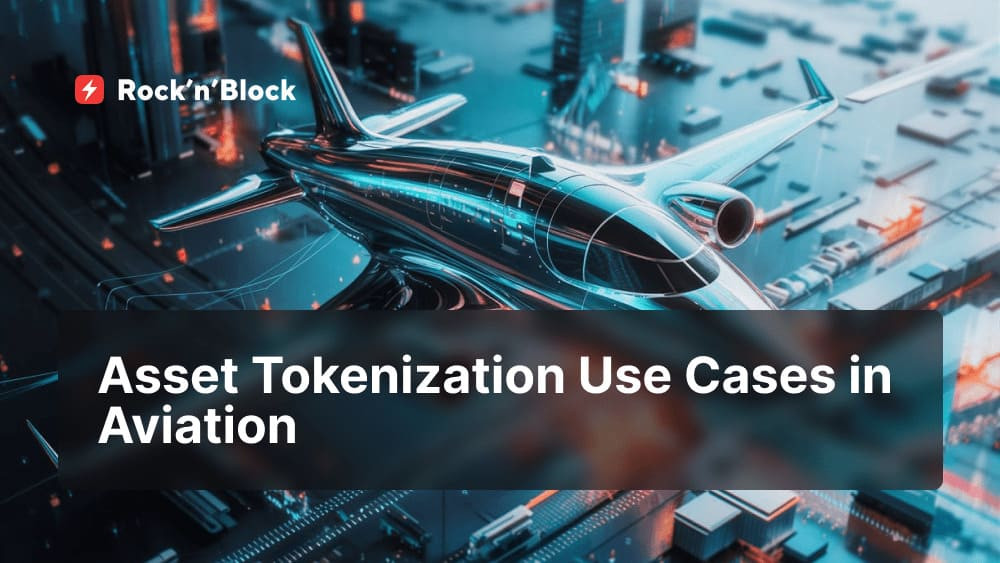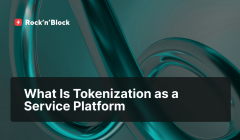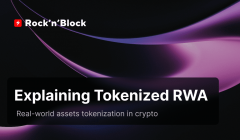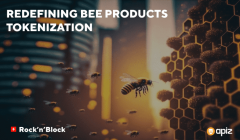Asset Tokenization Use Cases in Aviation
03 May 2024The idea of asset tokenization has emerged as a transformative force, reshaping the way aircraft ownership and investment are approached. Aviation assets of all kinds, from commercial airliners to ground support equipment, are being digitized and fractionalized, creating new opportunities for stakeholders. This guide covers the fundamentals of asset tokenization and its practical applications in the aviation sector. Join us as we uncover the transformative potential of aviation asset tokenization!

Table of Contents:
-
What Is Assets Tokenization
-
Overview of Assets Tokenization in Aviation
-
How Aviation Asset Tokenization Benefits Aircraft Owners
-
Types of Aviation Assets
-
The Process of Aviation Assets Tokenization
-
Prominent Examples
-
Conclusion
💡 What Is Assets Tokenization
In the modern, evolving financial landscape, traditional asset ownership and investment models are being reshaped by innovative technologies. Asset tokenization is one such technology that has gained significant adoption in recent years. Asset tokenization allows ownership or a share of an underlying asset to be represented by tokens that can be easily traded, transferred, and exchanged. But what exactly is asset tokenization and why is it important?
Defining Asset Tokenization
Asset tokenization involves breaking down the ownership of an asset into smaller, more liquid parts represented by digital tokens. These tokens are stored on a blockchain, a decentralized and immutable ledger technology that ensures transparency, security, and efficiency. Each token is unique and can be programmed with specific functionalities, such as dividend payments, voting rights, or access to asset-related services.
Applications of Asset Tokenization
Real-world assets tokenization has applications across various industries. For example:
Real Estate: Fractional ownership of commercial properties allows investors to diversify their portfolios and access passive rental income.
Venture Capital: Startups can tokenize equity shares, enabling early-stage investors to participate in the growth potential of promising companies.
Fine Art: Fractional ownership of artwork grants art enthusiasts the opportunity to invest in valuable pieces and benefit from potential appreciation.
Commodities: Tokenization of commodities like gold or oil provides investors with exposure to the underlying assets without the logistical challenges associated with physical ownership.
Intellectual Property: Tokenizing patents, copyrights, and royalties enables creators to monetize intellectual property and investors to share in revenue streams.
One significant application of asset tokenization is aviation asset tokenization, where aircraft, engines, and related assets are tokenized to enable fractional ownership and enhance liquidity. In this article, we will focus on exploring the implications and benefits of tokenizing aviation assets.
✈️ Overview of Assets Tokenization in Aviation
Aviation serves as a cornerstone of the global economy, contributing a staggering $3.5 trillion to global GDP. To put this into perspective, if aviation were a sovereign nation, it would rank as the 17th largest economy worldwide. Such statistics underscore the immense economic significance and attractiveness of the aviation industry for investments. With its substantial economic impact and indispensable role in facilitating global trade, tourism, and connectivity, aviation presents unparalleled opportunities for investors seeking stable returns and long-term growth potential.
At the same time aviation industry is experiencing a significant shift with the introduction of aviation assets tokenization that allows more opportunities for investment. Aviation asset tokenization harnesses the power of blockchain technology to digitize ownership rights and streamline asset management processes within the aviation industry. Through the issuance of digital tokens, aviation assets can be divided into smaller, more tradable units, enabling fractional ownership and facilitating peer-to-peer transactions.
These tokens are securely recorded on a decentralized ledger, providing immutable proof of ownership and transparent transaction history. Moreover, tokenization platforms often incorporate smart contracts, self-executing programs that automate asset transfers, lease payments, and other contractual obligations, further enhancing efficiency and reducing administrative overhead.
🛫 How Aviation Asset Tokenization Benefits Aircraft Owners
Aviation asset tokenization is a revolutionary technology that is transforming the way aircraft ownership and investment are approached. As stakeholders across the industry embrace this transformative technology, the potential for aviation asset tokenization to reshape aircraft financing, leasing and ownership is immense.
Enhanced Liquidity
One of the primary advantages of aviation asset tokenization is the increased liquidity it offers to traditionally illiquid aviation assets. By fractionalizing ownership, tokenization enables investors to buy and sell smaller portions of an aircraft or engine, unlocking liquidity and reducing barriers to entry. This enhanced liquidity not only benefits investors seeking to diversify their portfolios but also facilitates capital formation and accelerates asset turnover within the aviation industry.
Improved Accessibility
Aviation asset tokenization democratizes access to aviation investments, making them more accessible to a broader range of participants. Previously, direct ownership of aircraft or engines was primarily limited to institutional investors or high-net-worth individuals due to the substantial capital requirements and regulatory constraints involved. With tokenization, retail investors could acquire fractional ownership in aviation assets, thereby democratizing investment opportunities and fostering greater financial inclusion.
Transparency and Efficiency
Blockchain technology underlying aviation asset tokenization increases transparency and efficiency throughout the asset lifecycle. Tokenization platforms use a tamper-proof ledger to record ownership rights and transactional data, providing stakeholders with real-time visibility into asset ownership, maintenance history, and utilization patterns. This transparency builds trust among investors and helps ensure compliance with regulatory requirements while reducing the risk of fraudulent activities or disputes.
Innovative Funding Models
Aviation asset tokenization introduces innovative financing models that revolutionize traditional aircraft leasing and financing practices. Instead of relying solely on bank loans or capital markets for aircraft acquisition, airlines and owners can explore alternative funding sources, such as tokenized asset-backed securities or peer-to-peer lending platforms. These novel financing mechanisms offer greater flexibility, lower transaction costs, and faster execution, thereby empowering stakeholders to optimize their capital structures and adapt to evolving market conditions.
Streamlined Asset Management and Compliance
Managing a diverse portfolio of aircraft assets can be a complex process involving multiple stakeholders, regulatory requirements, and contractual obligations. Aviation asset tokenization simplifies asset management by digitizing ownership records, lease agreements, and maintenance logs on a blockchain platform. This ledger is transparent and immutable, providing stakeholders with real-time visibility into asset performance, utilization rates, and compliance status. This reduces administrative overhead and minimizes the risk of disputes or discrepancies. Tokenization platforms often incorporate smart contracts, which enhance operational efficiency and ensure regulatory compliance.
Facilitated Portfolio Diversification and Risk Mitigation
For aircraft owners looking to diversify their portfolios and mitigate risks, aviation asset tokenization offers a flexible and cost-effective solution. By fractionalizing ownership and enabling investors to acquire shares in specific aircraft or projects, tokenization allows owners to spread their investments across multiple assets, geographic regions, or leasing segments. This diversification strategy helps mitigate concentration risk and exposure to specific market fluctuations, ensuring a more resilient and balanced portfolio. Moreover, tokenization facilitates the securitization of aircraft assets, enabling owners to create asset-backed securities (ABS) or collateralized loan obligations (CLOs) that appeal to institutional investors seeking stable returns and asset-backed investments.
Investor Engagement and Transparency
By aviation asset tokenization, aircraft owners and projects can enhance investor engagement and transparency, building trust and confidence among stakeholders. Digital tokens represent tangible ownership rights in specific aircraft or projects, providing investors with transparent and immutable records of ownership, transactions, and asset performance. This transparency fosters greater investor confidence, encourages participation in aviation investments, and strengthens relationships between owners and investors.
🌐 Types of Aviation Assets
The aviation industry relies on a diverse array of assets to drive growth, each serving a distinct purpose in ensuring safe and efficient air travel. Let's explore the various types of aviation assets and their potential for tokenization in this evolving landscape.
Commercial Aircraft
Commercial aircraft represent the backbone of the aviation industry, transporting passengers and cargo across continents with efficiency and reliability. These high-value assets, ranging from narrow-body jets to wide-body airliners, are typically owned by airlines, leasing companies, or institutional investors.
Asset tokenization offers an innovative approach to unlock the value of commercial aircraft by dividing ownership into digital tokens. Fractional ownership models allow investors to acquire shares in specific aircraft, diversifying their portfolios and gaining exposure to the lucrative aviation market. Moreover, tokenization facilitates the trading on secondary markets, enhancing liquidity and enabling investors to capitalize on market opportunities.
Business Jets
Business jets cater to the needs of corporate executives, high-net-worth individuals, and VIP travelers seeking privacy, flexibility, and luxury in air travel. These premium assets, including private jets, turboprops, and helicopters, offer unparalleled convenience and customization options for discerning passengers.
Asset tokenization presents a compelling opportunity for fractional ownership of business jets, allowing investors to access the benefits of private aviation without the prohibitive costs of sole ownership.
Airports
Airports serve as vital hubs for air travel, facilitating the movement of passengers, cargo, and aircraft across the globe. These sprawling infrastructures encompass terminals, runways, taxiways, and ancillary facilities, making them integral components of the aviation ecosystem.
Asset tokenization offers a groundbreaking approach to unlock the value of airports by fractionalizing ownership and digitizing assets such as terminal space, parking facilities, and retail concessions. Investors can acquire shares in airport portfolios, diversifying their investment and gaining exposure to the steady revenue streams generated by airport operations.
Tickets
Tickets are essential for air travel and can be tokenized using blockchain technology. This transition from static to dynamic assets unlocks new revenue streams and enhances the customer experience. Digitized tickets offer enhanced security, streamlined transactions, and liquidity. Tokenization also enables dynamic pricing and secondary markets, revolutionizing passenger access to air travel services.
Helicopters
Helicopters serve diverse missions, including corporate transport, emergency medical services, law enforcement, and aerial photography. These versatile aircraft offer vertical takeoff and landing capabilities, making them indispensable assets for various industries and applications. Asset tokenization presents opportunities for fractional ownership of helicopters, enabling investors to access the benefits of rotorcraft operations without the costs of sole ownership. By tokenizing helicopter assets, owners can optimize utilization rates, reduce idle time, and maximize revenue generation from helicopter fleets.
Leasing Rights
Leasing rights encompass contractual agreements that grant lessees the exclusive use of aviation assets for a specified period. These rights can pertain to aircraft, hangar space, ground handling equipment, or other aviation-related facilities. Asset tokenization facilitates the fractional ownership of leasing rights, enabling investors to participate in the rental income generated by leased assets. By tokenizing leasing rights, lessors can diversify their revenue streams, mitigate risks, and optimize the utilization of leased assets.
Loyalty Points & Rewards
Loyalty points and rewards programs are integral components of airline marketing strategies, incentivizing customer loyalty and driving repeat business. These programs offer passengers a variety of benefits, including free flights, upgrades, lounge access, and exclusive perks. Asset tokenization enables the fractional ownership of loyalty points and rewards, allowing investors to participate in the value generated by airline loyalty programs. By tokenizing loyalty points, airlines can unlock additional revenue streams, monetize points liabilities, and enhance customer engagement.
Aviation assets encompass a diverse range of high-value equipment and vehicles that are essential for the safe and efficient operation of air travel. With the advent of asset tokenization technology, these aviation assets present unprecedented opportunities for fractional ownership, enhanced liquidity, and innovative investment models.
⚙️ The Process of Aviation Assets Tokenization
Let's explore a step-by-step process for aviation assets tokenization, from initial planning to implementation and beyond.
Step 1: Asset Selection and Due Diligence
The first step in the tokenization process involves identifying suitable aviation assets for tokenization and conducting comprehensive due diligence. This includes evaluating the market value, legal ownership structure and operational history of the assets. Whether it's commercial aircraft, engines, spare parts, or ground support equipment, careful consideration must be given to asset characteristics, market demand, and investor preferences.
Step 2: Legal and Regulatory Compliance
Once the assets have been selected, it's essential to navigate the legal and regulatory landscape governing aviation asset tokenization. This includes complying with aviation regulations, securities laws, and data privacy regulations applicable to tokenized assets.
Step 3: Technology Infrastructure and Platform Selection
Selecting a robust technology infrastructure and tokenization platform is crucial to the success of the tokenization process. This involves choosing a blockchain protocol, smart contract framework, and tokenization platform that meets the specific requirements of aviation asset tokenization. Factors to consider include scalability, security, interoperability, and regulatory compliance capabilities of the chosen platform.
Explore our guide on How to Choose Blockchain for Token Development!
Step 4: Asset Structuring and Fractionalization
The next step is to structure the tokenization of aviation assets and determine the fractional ownership model. This involves dividing the ownership of the assets into digital tokens, each representing a fraction of the underlying asset. Fractionalization can be based on various criteria, such as asset value, usage rights, or revenue-sharing arrangements, depending on the preferences of the asset owners and investors.
Step 5: Token Issuance and Distribution
Once the technology infrastructure is in place, the next step is to issue and distribute digital tokens representing fractional ownership rights in the aviation assets. This involves assets tokenization on the blockchain, including metadata such as ownership rights, usage terms, and dividend distribution mechanisms. Tokens can then be distributed to investors through a public or private offering, depending on regulatory requirements and investor preferences.
Step 6: Secondary Market Trading and Liquidity Provision
After issuing tokens, it is possible to trade tokenized aviation assets in the secondary market and increase liquidity. This may involve listing tokens on regulated platforms that implement measures such as Anti-Money Laundering (AML) and Know Your Customer (KYC) to ensure compliance with regulatory requirements and investor accreditation standards.
Step 7: Asset Management and Governance
Throughout the tokenization process, ongoing asset management and governance are essential to ensure the effective operation and compliance of tokenized aviation assets. This includes monitoring asset performance, maintaining regulatory compliance, and implementing governance mechanisms to address shareholder rights, voting procedures, and dispute resolution processes.
Step 8: Investor Relations and Communication
Last but not least, maintaining transparent and proactive communication with investors and stakeholders is crucial to building trust and confidence in tokenized aviation assets. This involves providing regular updates on asset performance, financial reporting, and strategic developments, as well as addressing investor inquiries and concerns in a timely and transparent manner.
By following this step-by-step process, stakeholders can unlock the potential of aviation assets tokenization and capitalize on the benefits of fractional ownership, enhanced liquidity, and innovative investment models.
⚡️ Prominent Examples
iRA Blocks
One of the most notable examples of companies offering aviation asset tokenization is iRa Blocks, a revolutionary platform that uses blockchain technology to redefine asset ownership.
iRA Blocks stands as a revolutionary platform harnessing blockchain technology to redefine asset ownership paradigms. Through fractional tokenization, the platform facilitates investor access to high-value physical assets, spanning from real estate to aviation and maritime assets. Focused on transparency, security, and efficiency, iRA Blocks ensures a seamless and user-friendly experience, thereby democratizing investment opportunities and enabling portfolio diversification.
TravelX
TravelX is leading the charge in transforming air travel through NFT tickets. By tokenizing air tickets, TravelX dynamically enhances revenue and customer experience. Its advanced algorithm clusters flights and passengers, enabling personalized repurchase offers. Flybondi is the first airline to tokenize 100% of its inventory with the support of TravelX and Algorand. With over 60 airlines in discussions to adopt NFTickets, TravelX is reshaping the aviation landscape. By January 2, 2024, over 5 million passengers have experienced the transformative power of TravelX's NFTickets, marking a significant milestone in the evolution of air travel.
Conclusion
Aviation assets tokenization represents a groundbreaking evolution in the aviation industry, unlocking new opportunities for ownership, investment, and innovation. Asset tokenization holds immense promise for shaping the future of aviation finance and investment. The potential for tokenization to drive growth, efficiency, and sustainability in aviation is truly boundless. By harnessing the power of blockchain technology and asset tokenization, the aviation industry is poised to soar to new heights, creating value for stakeholders and passengers alike.
We ❤️ Development
Follow us on social media to receive the hottest blockchain development updates
Twitter ⚡️Telegram⚡️LinkedIn⚡️Facebook







